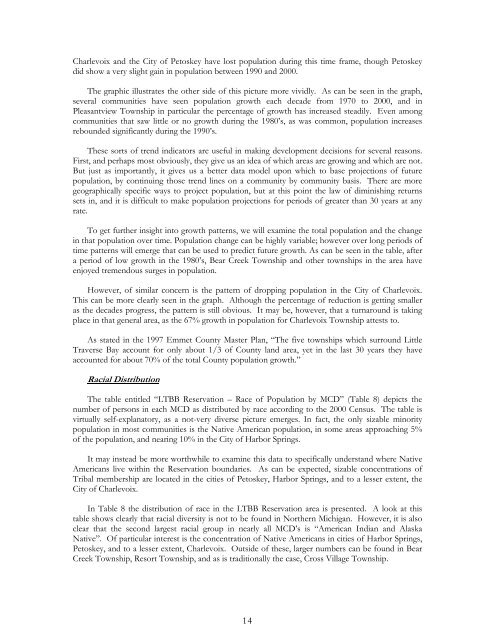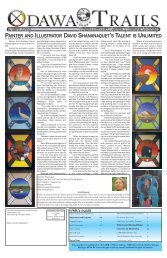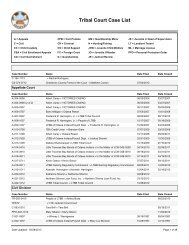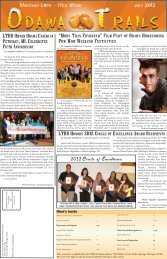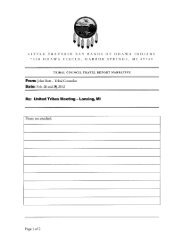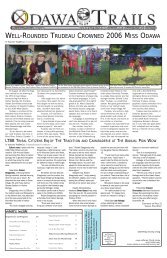LTBB Master Land Use Plan - Little Traverse Bay Bands of Odawa ...
LTBB Master Land Use Plan - Little Traverse Bay Bands of Odawa ...
LTBB Master Land Use Plan - Little Traverse Bay Bands of Odawa ...
Create successful ePaper yourself
Turn your PDF publications into a flip-book with our unique Google optimized e-Paper software.
Charlevoix and the City <strong>of</strong> Petoskey have lost population during this time frame, though Petoskey<br />
did show a very slight gain in population between 1990 and 2000.<br />
The graphic illustrates the other side <strong>of</strong> this picture more vividly. As can be seen in the graph,<br />
several communities have seen population growth each decade from 1970 to 2000, and in<br />
Pleasantview Township in particular the percentage <strong>of</strong> growth has increased steadily. Even among<br />
communities that saw little or no growth during the 1980’s, as was common, population increases<br />
rebounded significantly during the 1990’s.<br />
These sorts <strong>of</strong> trend indicators are useful in making development decisions for several reasons.<br />
First, and perhaps most obviously, they give us an idea <strong>of</strong> which areas are growing and which are not.<br />
But just as importantly, it gives us a better data model upon which to base projections <strong>of</strong> future<br />
population, by continuing those trend lines on a community by community basis. There are more<br />
geographically specific ways to project population, but at this point the law <strong>of</strong> diminishing returns<br />
sets in, and it is difficult to make population projections for periods <strong>of</strong> greater than 30 years at any<br />
rate.<br />
To get further insight into growth patterns, we will examine the total population and the change<br />
in that population over time. Population change can be highly variable; however over long periods <strong>of</strong><br />
time patterns will emerge that can be used to predict future growth. As can be seen in the table, after<br />
a period <strong>of</strong> low growth in the 1980’s, Bear Creek Township and other townships in the area have<br />
enjoyed tremendous surges in population.<br />
However, <strong>of</strong> similar concern is the pattern <strong>of</strong> dropping population in the City <strong>of</strong> Charlevoix.<br />
This can be more clearly seen in the graph. Although the percentage <strong>of</strong> reduction is getting smaller<br />
as the decades progress, the pattern is still obvious. It may be, however, that a turnaround is taking<br />
place in that general area, as the 67% growth in population for Charlevoix Township attests to.<br />
As stated in the 1997 Emmet County <strong>Master</strong> <strong>Plan</strong>, “The five townships which surround <strong>Little</strong><br />
<strong>Traverse</strong> <strong>Bay</strong> account for only about 1/3 <strong>of</strong> County land area, yet in the last 30 years they have<br />
accounted for about 70% <strong>of</strong> the total County population growth.”<br />
Racial Distri bution<br />
The table entitled “<strong>LTBB</strong> Reservation – Race <strong>of</strong> Population by MCD” (Table 8) depicts the<br />
number <strong>of</strong> persons in each MCD as distributed by race according to the 2000 Census. The table is<br />
virtually self-explanatory, as a not-very diverse picture emerges. In fact, the only sizable minority<br />
population in most communities is the Native American population, in some areas approaching 5%<br />
<strong>of</strong> the population, and nearing 10% in the City <strong>of</strong> Harbor Springs.<br />
It may instead be more worthwhile to examine this data to specifically understand where Native<br />
Americans live within the Reservation boundaries. As can be expected, sizable concentrations <strong>of</strong><br />
Tribal membership are located in the cities <strong>of</strong> Petoskey, Harbor Springs, and to a lesser extent, the<br />
City <strong>of</strong> Charlevoix.<br />
In Table 8 the distribution <strong>of</strong> race in the <strong>LTBB</strong> Reservation area is presented. A look at this<br />
table shows clearly that racial diversity is not to be found in Northern Michigan. However, it is also<br />
clear that the second largest racial group in nearly all MCD’s is “American Indian and Alaska<br />
Native”. Of particular interest is the concentration <strong>of</strong> Native Americans in cities <strong>of</strong> Harbor Springs,<br />
Petoskey, and to a lesser extent, Charlevoix. Outside <strong>of</strong> these, larger numbers can be found in Bear<br />
Creek Township, Resort Township, and as is traditionally the case, Cross Village Township.<br />
14


